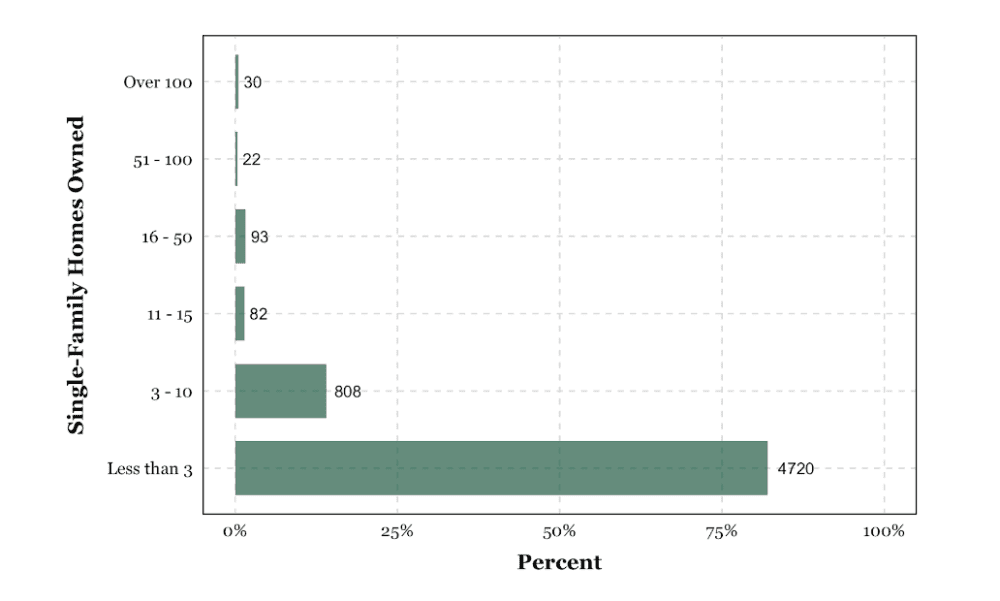Understanding corporate landlords: Who are they?

This article is the second in an informational series about corporate landlords. Click here to read the first article, “Understanding corporate landlords: Decoding a recent housing phenomenon,” and click here to read the third article, “Understanding corporate landlords: Where are they in Mecklenburg County?”
Identifying corporate landlords, sometimes referred to as real estate investment trusts (REITs) or institutional investors, can be a complicated process. Errors, including misspellings, inaccurate records, or missing information, are common in administrative data reporting (An et al., 2024). Corporate landlords can also have dozens of subsidiaries with unique names that mask the actual size of their portfolio.
So, how can we differentiate between “independent operations”, individuals who own one or two properties often under Limited Liability Companies (LLCs), mom-and-pop investors, those who own between three and nine properties, and the more large-scale operations of corporate landlords?
The research team at the Charlotte Urban Institute is developing a multi-step method to address this issue using the 2023 parcel-level tax data in Mecklenburg County (Mecklenburg County Land Records Management, 2024).
Identifying corporate owned single-family homes
According to Mecklenburg County, incorporated organizations owned around 29,000 single-family homes at the end of 2023 (2024). This includes corporations registered within and outside North Carolina as demonstrated in Table 1 below.

We take an additional step to search the property owner’s recorded name for terms commonly associated with corporate investors, as denoted by Redfin, The Washington Post, and the North Carolina Secretary of State. Our augmented conception of a corporate owner, therefore, includes any account indicated as containing keywords commonly associated with corporate landlords: corporation, incorporated, limited, LLC, and LP; in addition to accounts listed as a local (NC) or out-of-state (Non-NC) corporation.
This provides us with an initial number of 30,438 investor-owned houses, approximately 11.3% of all single-family homes in Mecklenburg County.
Linking similar corporations and their subsidiaries together
Scholars and practitioners have noted that many corporations own subsidiaries with slight deviations in their names. For example, American Homes 4 Rent appears to have over two dozen different subsidiaries listed as owners, including AMH NC Properties Two LP, AMH 2015-1 Borrower LP, AMH NC Development LLC, and AMH 2014-3 Borrower LP.
As owners’ names may not match perfectly, we use a technique known as fuzzy text search to find approximate matches or similarities between strings, i.e., owner names. While interested readers are encouraged to read the technical documentation for a complete description of this process, the goal is to create a new variable with a common name assigned to the owner names that are determined to be similar.
The process includes:
- Defining a threshold for grouping similar names
- Calculating the similarity between all owner names
- Identifying similar names by comparing the distances to the defined threshold
- Getting the names of similar investors as a list based on said comparison
- Iterating over each group and assigning a common name to each group
Simply put, each owner name is assigned a number that groups similar owner names together before we loop through each group and assign the most commonly used within said group.
Instead of relying on this manual grouping of similar corporations, we leverage The News & Observer (2022) and our previous work on the North Mecklenburg Demographic and Housing Assessment (Zager et al., 2023). The dataset provided by The Observer includes a crosswalk of the primary corporations and their various subsidiaries, similar to what we calculated manually above. At the same time, the North Mecklenburg report allows us to assign owners to specific corporations based on pattern matching within the common group names column. For example, if the common name contains the substring “AMH,” indicating a match to “AMH” in the name, it assigns the label “American Homes 4 Rent” to the common name column. If none of the patterns match, it converts the name value to a unique character.

This process reduces the number of “unique names” for owners of single-family homes in Mecklenburg County from 23,895 to 5,755.
The number of corporate landlords in Mecklenburg County

We now focus on separating corporate investors from non-corporate entities by examining the investor column to count the number of times a particular investor owns a single-family home. We then categorize the respective counts into particular ranges before summing the number of corporations within each range. Figure 1 demonstrates that approximately 80% of all corporate-owned single-family properties are held by a corporation with less than three properties in Mecklenburg County. 4,720 out of the 5,755 estimated corporations own either one or two single-family homes in our community, which would not meet the standard of these entities being labeled as corporate landlords.
How should we determine whether an investor is labeled a corporate landlord? While there are differing opinions on this issue, we elect to follow recent studies and label investors as corporate landlords when their names appear 15 or more times, indicating that the entity owns at least 15 properties in Mecklenburg County (Raymond et al., 2016; Goodman et al., 2023). We, therefore, estimate that 145 investors should be considered corporate landlords.
While 145 out of 5,755 investors can be classified as corporate landlords, how many single-family homes do corporate landlords own in Mecklenburg County?
Corporate landlords account for 67% (20,421) of all investor-owned single-family homes.
They also account for approximately 7.6% of all single-family homes (296,455) in Mecklenburg County.
Moving forward
Until recently, “corporate landlords” was a term commonly applied to any corporate owner. We have illustrated that most homeowners designated as a “corporation” own fewer than three single-family homes. Only 145 corporations, however, account for nearly 70% of all corporate-owned homes and just under eight percent of all single-family homes in Mecklenburg County. Differentiating corporate landlords from smaller corporations allows us to more accurately address several questions related to the presence of corporate landlords, including: 1) where are corporate landlords located within Mecklenburg County; 2) what is the value of homes owned by these entities; and 3) is there a relationship between the presence of corporate landlords and the racial/ethnic composition of the neighborhood?
References:
- An, B. Y., Jakabovics, A., Orlando, A. W., Rodnyansky, S., & Son, E. (2024). Who Owns America? A Methodology for Identifying Landlords’ Ownership Scale and the Implications for Targeted Code Enforcement. Journal of the American Planning Association, 1-15.
- Goodman, L., Zinn, A., Reynolds, K., & Noble, E. (2023). A profile of institutional investor–owned single-family rental properties. Urban Institute.
- Mecklenburg County Land Records Management. (2024). Tax parcels with CAMA data, 2023 [Data set]. Mecklenburg County GIS. https://mecklenburgcounty.hosted-by-files.com/OpenMapping/Parcel%20Data%20Archive/
- Raymond, E. L., Duckworth, R., Miller, B., Lucas, M., & Pokharel, S. (2016). Corporate landlords, institutional investors, and displacement: Eviction rates in single-family rentals. FRB Atlanta community and economic development discussion paper, (2016-4).
- Zager, K., Jackson-Gordon, R., McCoy, B. (2023). 2023 North Mecklenburg demographic and housing assessment: Report update. UNC Charlotte Urban Institute.